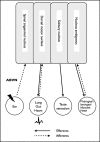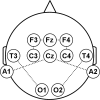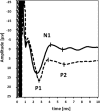Assessment of brainstem function with auricular branch of vagus nerve stimulation in Parkinson's disease
- PMID: 25849807
- PMCID: PMC4388709
- DOI: 10.1371/journal.pone.0120786
Assessment of brainstem function with auricular branch of vagus nerve stimulation in Parkinson's disease
Abstract
Background: The efferent dorsal motor nucleus of the vagal nuclei complex may degenerate early in the course of Parkinson's disease (PD), while efferent nucleus ambiguous, the principal source of parasympathetic vagal neurons innervating the heart, and afferent somatosensory nuclei remain intact.
Objective: To obtain neurophysiological evidence related to this pattern, we tested processing of afferent sensory information transmitted via the auricular branch of the vagus nerve (ABVN) which is known to be connected to autonomic regulation of cardiac rhythm.
Methods: In this cross-sectional observational study, we recorded (i) somatosensory evoked potentials (ABVN-SEP) and (ii) cutaneo-cardioautonomic response elicited by stimulation of the ABVN (modulation of heart-rate variability (HRV index; low frequency power, ln(LF), high frequency power, ln(HF); ln(LF/HF) ratio)) in 50 PD patients and 50 age and sex matched healthy controls. Additionally, auditory evoked potentials and trigeminal nerve SEP were assessed.
Results: Neither ABVN-SEP nor any of the other functional brainstem parameters differed between patients and controls. Although HRV index was decreased in PD patients, modulation of ln(LF/HF) by ABVN-stimulation, likely indicating cardiac parasympathetic activation, did not differ between both groups.
Conclusions: Findings do not point to prominent dysfunction of processing afferent information from ABVN and its connected parasympathetic cardiac pathway in PD. They are consistent with the known pattern of degeneration of the vagal nuclei complex of the brainstem.
Conflict of interest statement
Figures



Similar articles
-
Assessing blink reflex circuits by three different afferent routes in Parkinson's disease.Clin Neurophysiol. 2019 Apr;130(4):582-587. doi: 10.1016/j.clinph.2018.12.009. Epub 2019 Jan 19. Clin Neurophysiol. 2019. PMID: 30704843
-
Cardiovascular autonomic effects of transcutaneous auricular nerve stimulation via the tragus in the rat involve spinal cervical sensory afferent pathways.Brain Stimul. 2019 Sep-Oct;12(5):1151-1158. doi: 10.1016/j.brs.2019.05.002. Epub 2019 May 6. Brain Stimul. 2019. PMID: 31129152
-
The anatomical basis for transcutaneous auricular vagus nerve stimulation.J Anat. 2020 Apr;236(4):588-611. doi: 10.1111/joa.13122. Epub 2019 Nov 19. J Anat. 2020. PMID: 31742681 Free PMC article. Review.
-
The influence of respiration on brainstem and cardiovagal response to auricular vagus nerve stimulation: A multimodal ultrahigh-field (7T) fMRI study.Brain Stimul. 2019 Jul-Aug;12(4):911-921. doi: 10.1016/j.brs.2019.02.003. Epub 2019 Feb 10. Brain Stimul. 2019. PMID: 30803865 Free PMC article.
-
Afferent vagal modulation. Clinical studies of visceral sensory input.Auton Neurosci. 2001 Jul 20;90(1-2):35-40. doi: 10.1016/S1566-0702(01)00265-X. Auton Neurosci. 2001. PMID: 11485290 Review.
Cited by
-
Atrophy of the Vagus Nerve in Parkinson's Disease Revealed by High-Resolution Ultrasonography.Front Neurol. 2018 Sep 27;9:805. doi: 10.3389/fneur.2018.00805. eCollection 2018. Front Neurol. 2018. PMID: 30319534 Free PMC article.
-
Axonal Degeneration of the Vagus Nerve in Parkinson's Disease-A High-Resolution Ultrasound Study.Front Neurol. 2018 Nov 12;9:951. doi: 10.3389/fneur.2018.00951. eCollection 2018. Front Neurol. 2018. PMID: 30483212 Free PMC article.
-
Non-Invasive Auricular Vagus Nerve Stimulation Decreases Heart Rate Variability Independent of Caloric Load.Psychophysiology. 2025 Feb;62(2):e70017. doi: 10.1111/psyp.70017. Psychophysiology. 2025. PMID: 40007175 Free PMC article. Clinical Trial.
-
Heart Rate Variability Analyses in Parkinson's Disease: A Systematic Review and Meta-Analysis.Brain Sci. 2021 Jul 21;11(8):959. doi: 10.3390/brainsci11080959. Brain Sci. 2021. PMID: 34439578 Free PMC article. Review.
-
International Consensus Based Review and Recommendations for Minimum Reporting Standards in Research on Transcutaneous Vagus Nerve Stimulation (Version 2020).Front Hum Neurosci. 2021 Mar 23;14:568051. doi: 10.3389/fnhum.2020.568051. eCollection 2020. Front Hum Neurosci. 2021. PMID: 33854421 Free PMC article. Review.
References
-
- Braak H, Del Tredici K, Rüb U, de Vos Rob AI, Steur J, et al. Staging of brain pathology related to sporadic Parkinson's disease. Neurobiol. Aging. 2003; 24 (2): 197–211. - PubMed
-
- Heimer L, editor. The Human Brain and Spinal Cord Functional Neuroanatomy and Dissection Guide. New York NY: Springer; 1995.
-
- Cheng Z, Zhang H, Guo SZ, Wurster R, Gozal D. Differential control over postganglionic neurons in rat cardiac ganglia by NA and DmnX neurons: anatomical evidence. Am. J. Physiol. Regul. Integr. Comp. Physiol. 2004; 286 (4): R625–33. - PubMed
-
- Cheng Z, Powley TL, Schwaber JS, Doyle FJ. Projections of the dorsal motor nucleus of the vagus to cardiac ganglia of rat atria: an anterograde tracing study. J. Comp. Neurol. 1999; 410 (2): 320–341. - PubMed
Publication types
MeSH terms
LinkOut - more resources
Full Text Sources
Other Literature Sources
Medical
Research Materials
Miscellaneous

